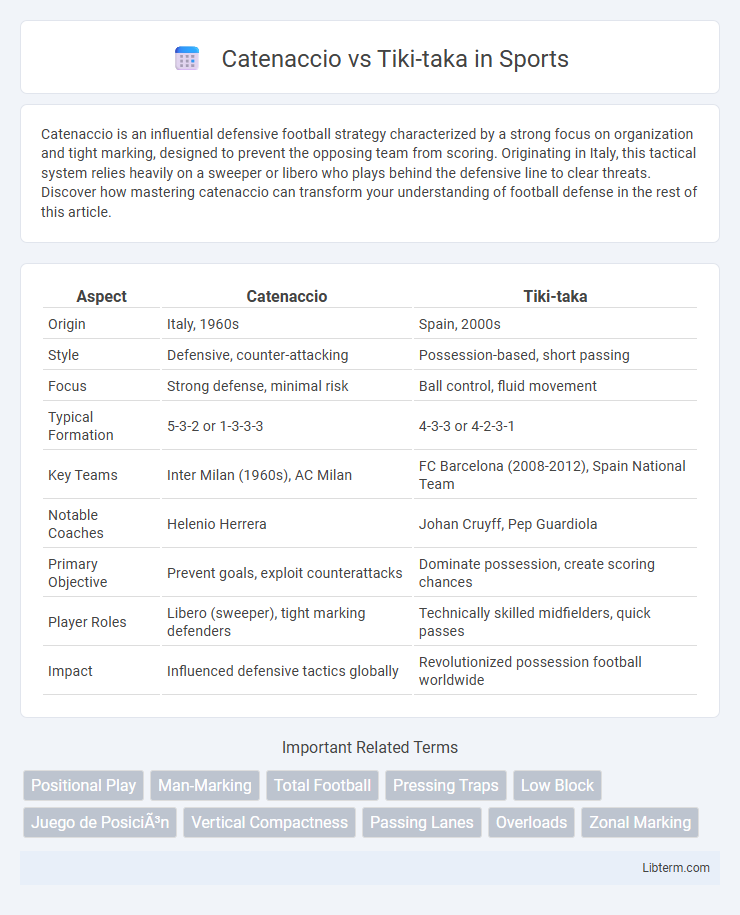Catenaccio is an influential defensive football strategy characterized by a strong focus on organization and tight marking, designed to prevent the opposing team from scoring. Originating in Italy, this tactical system relies heavily on a sweeper or libero who plays behind the defensive line to clear threats. Discover how mastering catenaccio can transform your understanding of football defense in the rest of this article.
Table of Comparison
| Aspect | Catenaccio | Tiki-taka |
|---|---|---|
| Origin | Italy, 1960s | Spain, 2000s |
| Style | Defensive, counter-attacking | Possession-based, short passing |
| Focus | Strong defense, minimal risk | Ball control, fluid movement |
| Typical Formation | 5-3-2 or 1-3-3-3 | 4-3-3 or 4-2-3-1 |
| Key Teams | Inter Milan (1960s), AC Milan | FC Barcelona (2008-2012), Spain National Team |
| Notable Coaches | Helenio Herrera | Johan Cruyff, Pep Guardiola |
| Primary Objective | Prevent goals, exploit counterattacks | Dominate possession, create scoring chances |
| Player Roles | Libero (sweeper), tight marking defenders | Technically skilled midfielders, quick passes |
| Impact | Influenced defensive tactics globally | Revolutionized possession football worldwide |
Origins and Historical Development
Catenaccio, an Italian defensive system emerging in the 1940s, emphasized strong man-marking and a libero playing behind the defense to intercept attacks. Tiki-taka originated in Spain, popularized by FC Barcelona and the Spanish national team in the early 2000s, relying on short passing, ball possession, and positional play. Both tactics evolved through influential coaches: Helenio Herrera for Catenaccio and Johan Cruyff, later refined by Pep Guardiola, for Tiki-taka.
Core Philosophies Explained
Catenaccio emphasizes strong defensive organization, relying on a libero or sweeper to neutralize opposing attacks and counterattack swiftly. Tiki-taka centers on maintaining high possession through short, precise passes and fluid movement, aiming to control tempo and systematically dismantle defenses. Both philosophies prioritize strategic execution, with Catenaccio focusing on defensive solidity and Tiki-taka on offensive dominance through teamwork and ball control.
Tactical Formations and Structures
Catenaccio relies on a highly structured defensive formation centered around a sweeper behind the backline, emphasizing tight man-marking and rapid counter-attacks. Tiki-taka utilizes a fluid 4-3-3 or 4-2-3-1 formation focused on short, precise passes and maintaining possession to control the midfield and tire opponents. The contrast lies in Catenaccio's disciplined, reactive structure versus Tiki-taka's dynamic, possession-based approach aimed at overwhelming opposition through spatial control.
Key Figures and Iconic Teams
Catenaccio, pioneered by Helenio Herrera at Inter Milan during the 1960s, emphasized defensive solidity and tactical discipline, with players like Giacinto Facchetti embodying its resilience. Tiki-taka, epitomized by Pep Guardiola's Barcelona in the late 2000s, showcased fluid ball possession and rapid passing, driven by key figures such as Xavi Hernandez and Andres Iniesta. Both tactical philosophies defined eras, with Catenaccio's Inter Milan and Tiki-taka's Barcelona leaving lasting legacies in football history.
Strengths and Weaknesses
Catenaccio excels in strong defensive organization and rapid counter-attacks, creating resilience against aggressive opponents but often sacrificing offensive creativity and ball possession. Tiki-taka emphasizes high ball retention and intricate passing patterns, which dominate possession and wear down defenses, yet it can struggle against highly physical teams and may lack directness in goal-scoring opportunities. Both tactics demand disciplined team roles: Catenaccio relies heavily on a sweeper and defenders, while Tiki-taka requires technically skilled midfielders and forwards for fluid, short-passing movements.
Impact on Modern Football
Catenaccio's defensive organization and counter-attacking principles have influenced modern football's emphasis on tactical discipline and structured backlines, shaping teams that prioritize solidity and rapid transitions. Tiki-taka's possession-based approach revolutionized playing styles by promoting short passes, spatial awareness, and high pressing, inspiring clubs and national teams to adopt fluid, ball-retention strategies. The integration of both styles underscores the evolution of contemporary football, blending defensive resilience with creative possession play for balanced team performance.
Famous Matches Showcasing Each Style
The 1982 FIFA World Cup Final between Italy and West Germany exemplified Catenaccio's defensive mastery, with Italy's disciplined backline and swift counterattacks securing a 3-1 victory. Conversely, Spain's dominant performance in the 2010 FIFA World Cup Final against the Netherlands highlighted Tiki-taka's intricate passing and possession control, resulting in a 1-0 win through Andres Iniesta's decisive goal. These matches remain iconic demonstrations of Catenaccio's robust defense versus Tiki-taka's fluid ball retention and movement.
Adaptations and Evolutions Over Time
Catenaccio, originating from Italian football, evolved from a rigid defensive system into a more flexible strategy incorporating swift counterattacks and zonal marking to adapt to modern pressing and ball possession trends. Tiki-taka, championed by Spanish teams like FC Barcelona and the Spanish national squad, has evolved by emphasizing continuous short passes, spatial awareness, and dynamic positional rotations to overcome organized defenses and maintain possession dominance. Both systems show adaptability by integrating elements of pressing intensity and transitional play to meet the demands of contemporary football tactics.
Cultural Influences on Playing Style
Catenaccio, rooted in Italian defensive discipline, emphasizes tight marking, counter-attacks, and team organization reflecting Italy's tactical pragmatism and historical focus on strong defense. Tiki-taka, originating from Spain, showcases short passing, maintaining ball possession, and fluid movement inspired by the cultural value placed on artistry, creativity, and collective teamwork. These playing styles not only define football tactics but also mirror the distinct cultural identities and strategic philosophies of their respective countries.
Future of Catenaccio and Tiki-taka
The future of Catenaccio hinges on its adaptation to modern, high-pressing football, integrating more fluid defensive transitions to counteract fast-paced attacking styles. Tiki-taka will continue evolving with advanced data analytics and positional play innovations, emphasizing quick passing and spatial control to dominate possession. Both tactics are likely to merge adaptive elements, balancing defensive solidity with offensive creativity in next-generation football strategies.
Catenaccio Infographic

 libterm.com
libterm.com